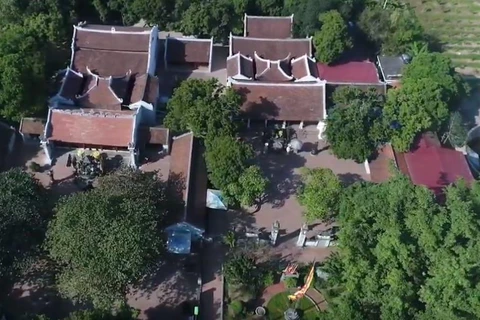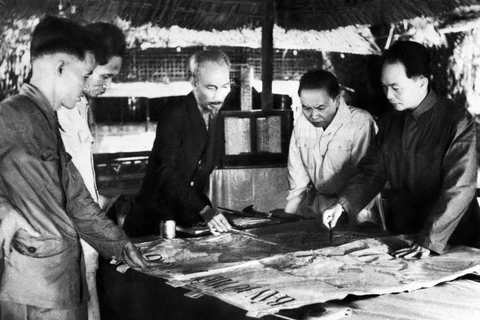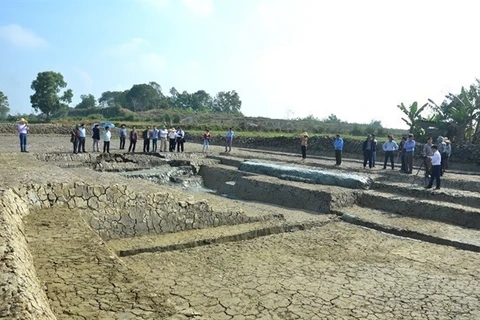Hanoi (VNA) - Archaeologists have recently unearthed wooden stakes that are thought to have been planted in a river in the coastal city of Hai Phong to repel Yuan-Mongol invaders' boats and secure the Bach Dang River victory in 1288 for Dai Viet (then Vietnam).
Researcher Bui Van Hieu from the Vietnam Archaeology Institute said the stakes would have been deployed by Tran Dynasty (1226-1400) fighters as a trap to destroy enemy boats and divert the current.
The historic victory reported in records has been proved by traces of wooden stakes on the river bed found in Yen Giang, Dong Van Muoi and Dong Ma Ngua in the northern province of Quang Ninh.
Recently, traces of the same wooden stakes have been unearthed in Lien Khe commune, Thuy Nguyen district, Hai Phong city.
They were discovered by chance near the Da Bac River dyke by locals. The stakes measured 3-4m in height with a diameter of 30cm.
Experts examined the stakes and decided to excavate the site. Nine stakes were found in early November 2019, which were tested by radio carbon [carbon-14] dating that found they came from between 1270 and 1430 AD.
At the end of November, the site was expanded to 950sq.m with three digs, where archaeologists found 27 stakes.
According to locals, this was not the first time such a discovery had been made. For example, 30 years ago a family found 10 stakes in the same area.
Tran Van Do, another farmer in Quy Khe village, found three wooden stakes in 1970, with diameters of 35-50cm.
Archaeologists have also examined Thu Khe Temple, Mai Dong Pagoda and Thiem Khe Pagoda, which history books say were involved in the victory.
According to records, Emperor Hung Dao Vuong Tran Quoc Tuan (1228-1300) visited the site to train his troops and set the trap.
Trap set
“We think this area was where the third battle of the Bach Dang River took place in 1288,” researcher Bui Van Hieu said. “The trap was likely designed to prevent Yuan-Mongol ships from entering Gia River where Tran Quoc Tuan’s army was. The invaders had no other choice but to travel along the Da Bac River to the Bach Dang River, where pointed stakes had been set to damage their boats.”
“The Bach Dang River victory ended the Yuan-Mongol troops hopes of invading Dai Viet,” he said.
Researcher Doan Dinh Lam, from the Vietnam Science Academy said feudal dynasties from the north that tried to invade Vietnam using the waterways chose the mouth of the Bach Dang River, which is deeper than the river itself.
Lam said he believed there were other stake traps set up along the river that were yet to be found.
Professor Le Van Lan said the findings changed what historians had previously thought of the battle.
"We only knew that the Tran army had lured the enemy down the Bach Dang River, and set the stakes late at night when the tide was high.
“The Tran army then engaged the enemy in the early morning when the tide was too low for their boats to flee to the sea. They were trapped by the wooden stakes,” he said.
“But now we know it was a huge military campaign, not just a single battle,” he said. “The Tran army planned to set up a system of traps all along the Bach Dang River.”
Researcher Vu Minh Giang, deputy chairman of the Culture Heritage Council, said many historians from around the world had praised the tactics.
“The Yuan-Mongol empire was extremely powerful,” he said. “It stretched from the Pacific Ocean to the Mediterranean Sea. They won every battle.
“In their efforts to invade Southeast Asia, they fought Dai Viet three times (1257-58; 1284-85 and 1287-88), and lost every time.
After their defeat in 1288, the empire gradually weakened and collapsed. The victory helped prevent the empire from invading Japan and Southeast Asia,” he said.
Professor Tran Dinh Thanh, deputy director of the Culture Heritage Department, said the new findings showed the great significance of the battle.
“Before scientists conducted separate research in different areas. Now we have connection. We should conduct more excavations and rebuild the victory in 3D images so that people can understand its scale. Many international scientists consider it a global victory, which should be regarded as a world heritage.”
Thanh suggested that local authorities should submit an application for recognition as a national relic site.
He also instructed agencies to protect the sites from erosion.
Bach Dang River, which runs through Quang Yen town (Quang Ninh province) to Thuy Nguyen district (Hai Phong city) also witnessed the historic victories of Ngo Quyen (897-944) and Le Hoan (941-1005)./.
Researcher Bui Van Hieu from the Vietnam Archaeology Institute said the stakes would have been deployed by Tran Dynasty (1226-1400) fighters as a trap to destroy enemy boats and divert the current.
The historic victory reported in records has been proved by traces of wooden stakes on the river bed found in Yen Giang, Dong Van Muoi and Dong Ma Ngua in the northern province of Quang Ninh.
Recently, traces of the same wooden stakes have been unearthed in Lien Khe commune, Thuy Nguyen district, Hai Phong city.
They were discovered by chance near the Da Bac River dyke by locals. The stakes measured 3-4m in height with a diameter of 30cm.
Experts examined the stakes and decided to excavate the site. Nine stakes were found in early November 2019, which were tested by radio carbon [carbon-14] dating that found they came from between 1270 and 1430 AD.
At the end of November, the site was expanded to 950sq.m with three digs, where archaeologists found 27 stakes.
According to locals, this was not the first time such a discovery had been made. For example, 30 years ago a family found 10 stakes in the same area.
Tran Van Do, another farmer in Quy Khe village, found three wooden stakes in 1970, with diameters of 35-50cm.
Archaeologists have also examined Thu Khe Temple, Mai Dong Pagoda and Thiem Khe Pagoda, which history books say were involved in the victory.
According to records, Emperor Hung Dao Vuong Tran Quoc Tuan (1228-1300) visited the site to train his troops and set the trap.
Trap set
“We think this area was where the third battle of the Bach Dang River took place in 1288,” researcher Bui Van Hieu said. “The trap was likely designed to prevent Yuan-Mongol ships from entering Gia River where Tran Quoc Tuan’s army was. The invaders had no other choice but to travel along the Da Bac River to the Bach Dang River, where pointed stakes had been set to damage their boats.”
“The Bach Dang River victory ended the Yuan-Mongol troops hopes of invading Dai Viet,” he said.
Researcher Doan Dinh Lam, from the Vietnam Science Academy said feudal dynasties from the north that tried to invade Vietnam using the waterways chose the mouth of the Bach Dang River, which is deeper than the river itself.
Lam said he believed there were other stake traps set up along the river that were yet to be found.
Professor Le Van Lan said the findings changed what historians had previously thought of the battle.
"We only knew that the Tran army had lured the enemy down the Bach Dang River, and set the stakes late at night when the tide was high.
“The Tran army then engaged the enemy in the early morning when the tide was too low for their boats to flee to the sea. They were trapped by the wooden stakes,” he said.
“But now we know it was a huge military campaign, not just a single battle,” he said. “The Tran army planned to set up a system of traps all along the Bach Dang River.”
Researcher Vu Minh Giang, deputy chairman of the Culture Heritage Council, said many historians from around the world had praised the tactics.
“The Yuan-Mongol empire was extremely powerful,” he said. “It stretched from the Pacific Ocean to the Mediterranean Sea. They won every battle.
“In their efforts to invade Southeast Asia, they fought Dai Viet three times (1257-58; 1284-85 and 1287-88), and lost every time.
After their defeat in 1288, the empire gradually weakened and collapsed. The victory helped prevent the empire from invading Japan and Southeast Asia,” he said.
Professor Tran Dinh Thanh, deputy director of the Culture Heritage Department, said the new findings showed the great significance of the battle.
“Before scientists conducted separate research in different areas. Now we have connection. We should conduct more excavations and rebuild the victory in 3D images so that people can understand its scale. Many international scientists consider it a global victory, which should be regarded as a world heritage.”
Thanh suggested that local authorities should submit an application for recognition as a national relic site.
He also instructed agencies to protect the sites from erosion.
Bach Dang River, which runs through Quang Yen town (Quang Ninh province) to Thuy Nguyen district (Hai Phong city) also witnessed the historic victories of Ngo Quyen (897-944) and Le Hoan (941-1005)./.
VNA























